I should add some background to make this clearer… my apologies if it gets too long.
I am a one man shop, not even a weekend warrior (maybe an “every other weekend warrior”), so only one power tool + dust collection can be used simultaneously. My shop is an attached 2 car unheated garage with concrete floors and 8’ ceilings. No plumbing or forced air into the garage.
After reading all the info here about the dangers of dust, I now always work with the garage doors and windows open and wear a cartridge respirator at all times while in the shop. For better “chip” collection, I am thinking of a 2HP DC that will vent outside (lucky me, I can vent out). The idea is that the DC would control chips and the open doors, windows and respirator should protect me from the fines. Maybe an air-cleaner will be added later.
So, now to the electrical issue:
Currently, all I have are two 15amp 110V circuits; one feeds the lighting, the garage door motors and one receptacle; the other one feeds exclusively one receptacle. The electrical panel in my house is 200amp, located in a basement wall adjacent to the garage (so, the shortest run from the panel to the garage is just the thickness of the wall). The panel has plenty of free slots.
Ideally, I would install a sub-panel, many breakers, outlets, and the like, but I don’t plan on staying in this house for more than just a few years; so I don’t want to invest too much money in a set-up that I will be leaving behind.
With the current set-up, the electrical demands of the lights, the shop-vac and small portable power tools are taken care off (no tripped breakers yet). So, I need to provide for the future machines.
I think that the maximum electrical demand would happen when running:
A) The 2HP 220v DC plus large 3HP 220V machine (e.g. a table saw)
Or
B) The 2HP 220v DC plus a large 110V machine (e.g. a 15amp router)
This is my initial thought: Install one 40amp 220v circuit, which will take care of (A) and one 20amp 110v breaker, which will finish to take care of (B).
The point that I am most unsure about is the 40amp breaker. Probably two 20amp 220v circuits would be better, but probably also more expensive? I am on tight budget here, so I want to reduce costs, but never at the expense of safety.
Any thoughts about the setup? Any ball-park ideas about costs? Do you know a good electrician that serves the Boston area (south shore)?
Thanks, and sorry for the lengthy post!
P.S. I forgot to add that I know very little about electricity, so everything will be done by a licensed electrician. But to have input in advance from some of you, will make me much better informed when I ask for estimates and discuss options with the electrician.





 Reply With Quote
Reply With Quote


 .
. 

 ) I have been thinking about my electrical needs for quite a while already. Every dollar I spend in wiring is a dollar I can't spend in wood/tools and viceversa. I am just trying to strike a balance I feel happy with.
) I have been thinking about my electrical needs for quite a while already. Every dollar I spend in wiring is a dollar I can't spend in wood/tools and viceversa. I am just trying to strike a balance I feel happy with.


